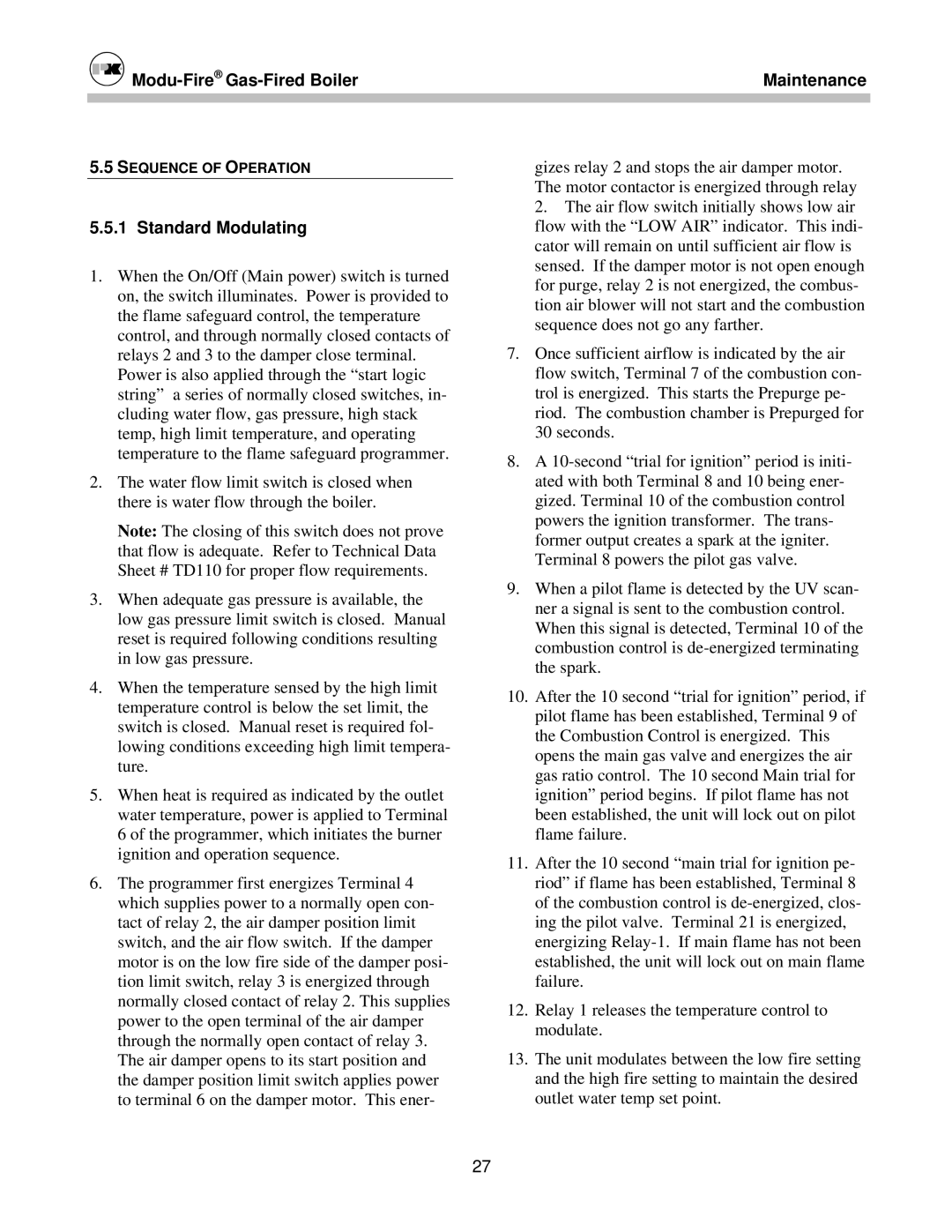

Modu-Fire® Gas-Fired Boiler
5.5SEQUENCE OF OPERATION
5.5.1 Standard Modulating
1.When the On/Off (Main power) switch is turned on, the switch illuminates. Power is provided to the flame safeguard control, the temperature control, and through normally closed contacts of relays 2 and 3 to the damper close terminal. Power is also applied through the “start logic string” a series of normally closed switches, in- cluding water flow, gas pressure, high stack temp, high limit temperature, and operating temperature to the flame safeguard programmer.
2.The water flow limit switch is closed when there is water flow through the boiler.
Note: The closing of this switch does not prove that flow is adequate. Refer to Technical Data Sheet # TD110 for proper flow requirements.
3.When adequate gas pressure is available, the low gas pressure limit switch is closed. Manual reset is required following conditions resulting in low gas pressure.
4.When the temperature sensed by the high limit temperature control is below the set limit, the switch is closed. Manual reset is required fol- lowing conditions exceeding high limit tempera- ture.
5.When heat is required as indicated by the outlet water temperature, power is applied to Terminal 6 of the programmer, which initiates the burner ignition and operation sequence.
6.The programmer first energizes Terminal 4 which supplies power to a normally open con- tact of relay 2, the air damper position limit switch, and the air flow switch. If the damper motor is on the low fire side of the damper posi- tion limit switch, relay 3 is energized through normally closed contact of relay 2. This supplies power to the open terminal of the air damper through the normally open contact of relay 3. The air damper opens to its start position and the damper position limit switch applies power to terminal 6 on the damper motor. This ener-
Maintenance
gizes relay 2 and stops the air damper motor. The motor contactor is energized through relay
2.The air flow switch initially shows low air flow with the “LOW AIR” indicator. This indi- cator will remain on until sufficient air flow is sensed. If the damper motor is not open enough for purge, relay 2 is not energized, the combus- tion air blower will not start and the combustion sequence does not go any farther.
7.Once sufficient airflow is indicated by the air flow switch, Terminal 7 of the combustion con- trol is energized. This starts the Prepurge pe- riod. The combustion chamber is Prepurged for
30seconds.
8.A
9.When a pilot flame is detected by the UV scan- ner a signal is sent to the combustion control. When this signal is detected, Terminal 10 of the combustion control is
10.After the 10 second “trial for ignition” period, if pilot flame has been established, Terminal 9 of the Combustion Control is energized. This opens the main gas valve and energizes the air gas ratio control. The 10 second Main trial for ignition” period begins. If pilot flame has not been established, the unit will lock out on pilot flame failure.
11.After the 10 second “main trial for ignition pe- riod” if flame has been established, Terminal 8 of the combustion control is
12.Relay 1 releases the temperature control to modulate.
13.The unit modulates between the low fire setting and the high fire setting to maintain the desired outlet water temp set point.
27
